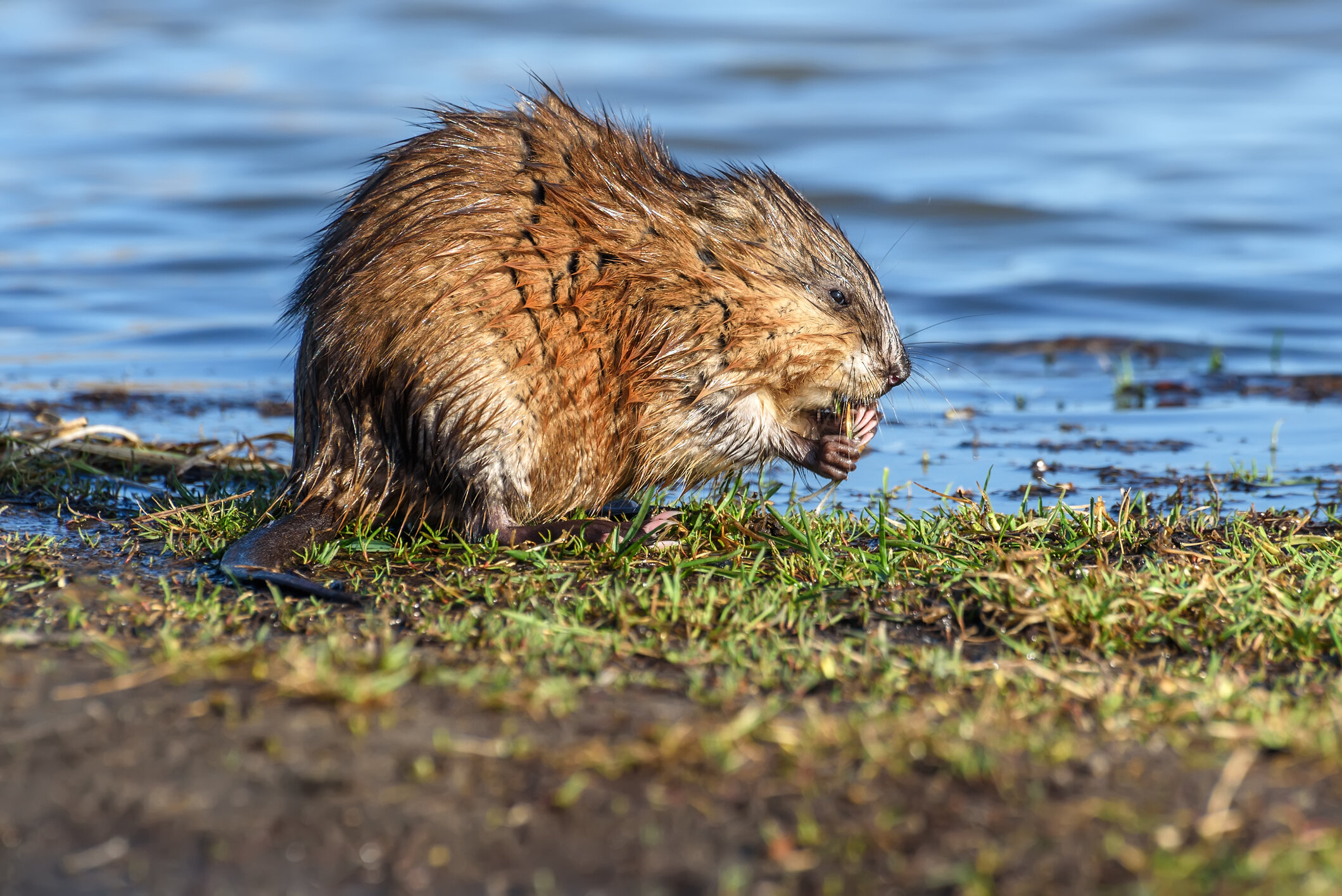Muskrat Pond Damage: Avoiding Damage and Costly Repairs
Muskrat Pond Damage explained by Dragonfly Pond Works’ expert.
Jared Beard- Client Service Manager, Wilmington, North Carolina and Myrtle Beach, South Carolina
If not managed properly, wildlife can cause significant damage to lakes, ponds, and stormwater systems. As with most potential issues, early detection is key to minimize damage, costly repairs, compliance violations, and/or fines. One mammal that may lead to destruction is the Muskrat.
Photo Credit: Istock/Iri_sha
The muskrat is a medium sized rodent found across most of the United States. Muskrats resemble small beavers, averaging 22-25 inches in length and 2-3 pounds as adults. Muskrats have quite a high reproductive rate. Each litter may contain 2-9 babies and females can have up to 5 litters per year. Muskrats prefer slow-moving or still water like ponds, lakes, marshes, and swamps. They primarily feed on aquatic plants such as cattails and bulrushes.
Muskrat’s choice of habitat, diet, and high reproductive rate can cause serious issues for lakes, ponds, and stormwater control measures. Muskrats either live in lodges that they build or burrows. They burrow into embankments and dams, creating a tunnel and nesting chamber. This will cause considerable erosion issues and in the case of a dam burrow, a potential dam failure. Understanding muskrat pond damage is imperative as a lake, pond, and stormwater maintenance company.
Identifying Muskrat Activity
Identifying wildlife activity as soon as possible helps minimize muskrat pond damage and costly repairs. You may not see a muskrat due to them being most active at dawn, dusk, and night. It is important to know what signs to look for to identify their presence. Dragonfly’s specialized pond and stormwater maintenance technicians look for signs of wildlife activity at every service and note any concerns in our detailed reports for clients.
-Look for holes about the size of a cup, generally found on the slope of the embankment near the top.
-In addition to holes, look for soft spots that look like they want to cave-in.
-Look for shoreline erosion with silt or sediment building up at the water’s edge due to muskrat movement in and out of water. Water flowing over this area will contribute to more erosion and sediment accumulation, leading to even more muskrat pond damage.
-Look for widening burrows and cave-ins.
-Look for collapsed banks and extreme erosion due to extensive burrowing.
Muskrat Pond Damage Issues
Shoreline erosion, which will worsen as water flows through and over the burrows.
Sediment accumulation in the pond as water flows over the burrows washing the material into the body of water.
Tunnels may cave-in if a mower drives over the top of them.
Tunnels or burrows in dams can lead to failures.
Burrows under and around pipes can lead to pipe separations which can lead to drainage issues and potential sinkholes.
All of these issues lead to unsafe conditions and potential compliance violations and/or fines.
Muskrats continually burrowed under this stormwater pipe, leading to a major pipe separation and a costly repair.
Example of shoreline erosion caused by muskrats and repaired by Dragonfly. Grass seed was spread with the matting in the final photo and grass will soon be established again.
Due to their preferred habitat and diet, muskrat pond damage can cause serious issues for HOA, municipality, and commercial lakes, ponds, and stormwater control measures. Once a muskrat has established a home, the most effective solution is having them trapped and removed from the area. Our specialized lake, pond, and stormwater maintenance services can help minimize the risk of muskrats by controlling and treating the vegetation they feed on and maintaining proper shoreline health. However, muskrats still may make your aquatic space their home, especially in more developed areas. Routine specialized maintenance will identify wildlife activity as soon as possible to minimize damage, repair costs, and violations/fines. Additionally, our experts can repair any damage caused by muskrats. Please contact us to learn more about how we can keep your system healthy and compliant.
Learn why Specialized Stormwater Maintenance is key to compliance and saving money!
Subscribe to our newsletter to receive informative and engaging news delivered right to your inbox.
Find us on Facebook, Twitter, Instagram, and LinkedIn for news, events, and more!
Dragonfly Pond Works is a lake, pond, and stormwater management company. We provide specialized maintenance, shoreline restoration, and more throughout North Carolina in Raleigh, Durham, Charlotte, Cary, and Wilmington. Our pond and lake maintenance services, shoreline restoration, and more can be found throughout Florida, in Tampa, St. Petersburg, Naples, Sarasota, Fort Myers, and Orlando. We also provide lake and pond maintenance in Myrtle Beach, Charleston, Columbia, South Carolina, and Atlanta, Georgia. We strive to develop long-term relationships based on quality work, timely service, cost-efficiency, and of course, trust.








